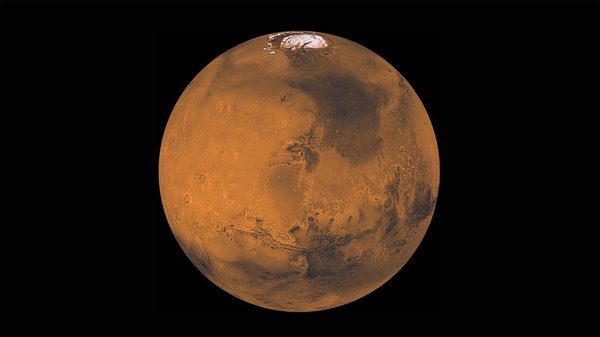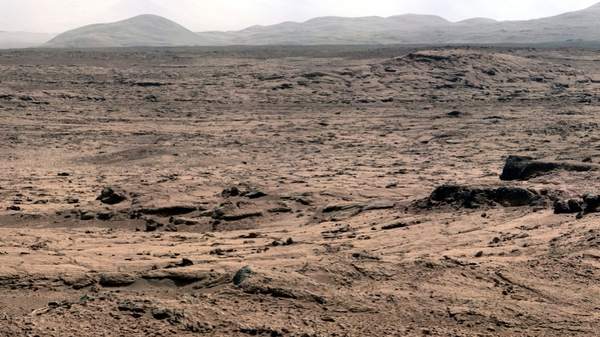Mars: The Red Planet
Fiery Mars can be one of the most dramatic objects in the night sky.

Mars has permanent polar ice caps. The north polar cap is visible here.
NASA/JPL/USGS
A Brief Overview of Mars
Mars is the fourth planet from the Sun. It is the outermost of the solar system’s small inner planets. The surface is rocky and dusty—the reddish color comes from particles of rust (iron oxide) in the dust.
Compare the sizes and order of the planets
Billions of years ago, Mars may have had rivers, lakes, and possibly a large ocean. Over time, however, the planet has lost most of its atmosphere, and today there is no liquid water on the surface.
Where Is Mars in the Sky?
Find and track Mars with our Interactive Night Sky Map
Check the weather in your town or city
When Is the Best Time to See Mars?
At its best, Mars is the fourth brightest object in our sky: a fiery red light that has inspired fear and wonder throughout human history. At its worst, Mars is dim and almost unnoticeable. The changes in its brightness are caused by its varying distance from Earth.
Mars is closest to Earth at opposition, when Earth passes between Mars and the Sun. By contrast, at solar conjunction—when Mars is on the opposite side of the Sun to Earth—the planet can be more than seven times farther away. Roughly speaking, Mars oppositions occur every 780 days (about 2 years and 50 days).
Next solar conjunction: January 9, 2026
Next opposition: February 19, 2027
Previous opposition: January 16, 2025
Previous solar conjunction: November 18, 2023
How far is Mars from Earth right now?

This photo of the Martian landscape was taken by the Curiosity rover.
NASA/JPL-Caltech/Malin Space Science Systems
How Long Is a Day and a Year?
The average length of a day is 24 hours, 39 minutes, and 35 seconds. When the first spacecraft began operating on Mars in the 1970s, planetary scientists started using the word “sol” to refer to a solar day on Mars.
A tropical year on Mars is approximately 687 Earth days, or 669 sols.
How Many Moons Does Mars Have?
Mars has two natural satellites, or moons. They are small, irregularly shaped rocks—possibly asteroids that became trapped in orbit around the planet. Both were discovered in August 1877.
The larger moon, Phobos, lies close to Mars. It circles the planet quickly, about three times per sol. Deimos, the smaller moon, lies further away; it takes about 1.2 sols to orbit Mars.
Every year, Phobos gets about 1.8 centimeters closer to Mars. Eventually, millions of years from now, it will crash into Mars, or perhaps break up into small pieces and form a ring of debris around the planet.

Phobos is a potato-shaped rock about 22 kilometers (14 miles) across. The most notable feature is a large crater called Stickney, which can be seen on the right side of this image.
NASA/JPL-Caltech/University of Arizona
Human Exploration of Mars
Humans have been studying Mars since ancient times. About 50 years after the invention of the telescope, Christiaan Huygens made the first crude map of Mars in 1659. He used his observations to estimate that the planet rotates roughly once every 24 hours.
On July 15, 1965 the Mariner 4 spacecraft passed within 10,000 kilometers (6000 miles) of Mars, and took the first close-up photographs of another planet. The barren landscape shown in the pictures more or less ended hopes for finding intelligent life on Mars.
Eleven years later, on July 20, 1976, Viking 1 landed on Mars and took the first photographs from the surface. Since then, there have been nine more successful Mars landings—most recently the Zhurong rover on May 14, 2021.
Why Mars has more leap years than Earth
How Long Does It Take to Get to Mars?
The best time to leave for Mars is when it’s close. This launch window occurs every 2 years and 50 days or so, around the time Mars is at opposition.
For instance, when Mars was at opposition in October 2020, three spacecraft traveled to the Red Planet; the journey time was just over six and a half months.
Emirates Mars Mission
- Launched: July 19, 2020
- Arrived: February 9, 2021
- Journey time: 6 months and 21 days (entered orbit)
Tianwen-1
- Launched: July 23, 2020
- Arrived: February 10, 2021
- Journey time: 6 months and 18 days (entered orbit)
Mars 2020
- Launched: July 30, 2020
- Arrived: February 18, 2021
- Journey time: 6 months and 19 days (landed)
All dates are shown in UTC.